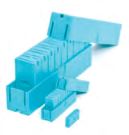Ten Block-of-100's fill the block-of-1000.
Students use specially-designed boxes (“holders”) to assemble single blocks into blocks-of-10; then they assemble these blocks-of-10 to make blocks-of-100.
They can assemble block-of-100 to make blocks-of-1000.
Digi-Blocks are a proven, teacher-tested, handson base 10 block learning system for K to Gr. 5+.
Compose and decompose values, the self-correcting "smart box" only closes when there are 10 blocks inside, eliminating recounting or trading.
Digi-Blocks instill a profound understanding of number sense fast, elegantly modeling all four arithmetic operations. Digi-Block grows with your students building on previous learning while modeling increasingly sophisticated mathematical topics:
place-value, factoring, division, decimals and more
Each Set Includes:
- 100 x 100 unit blocks,
- 10 x 10-holders
- 1 x 100-holder.
Choose from Classic and Power Blocks
For young children, who are not yet ready for the idea of shifting orders of magnitude, it may be advantageous not to start with the classical blocks.
The colours differentiatebetween tens, ones etc. This added multi-coloured scaffolding of Power Blocks supports addition and subtraction of the block sets.
More About Digi-Blocks
Digi-Blocks are a fantastic resource for helping children to understand conceptually and not merely procedurally how our place value system works. Young students build understanding of the unitizing of ones into countable groups of ten.
Unlike other materials, the ones can still be seen and manipulated to help those students who don't 'trust the count'; they can see the ones they have already counted within the blocks of ten and one hundred.
For older students, the proportional growth of the packs of ten, hundred, and thousand lead to conversations about the ongoing relative proportion of how physically large quantities are as they get ten times larger; it is consistently a surprise to them how much space one million would take up as they are led to visualize how large ten thousand would be, how large one hundred thousand would be, and low large one million would be.
In this way, the students conceptually understand that even though we only add one digit to the number, we are making the quantity so much larger. In a similar way, the decimal fractions set allows older students to actually see how much smaller one-tenth and one one-hundredth is.
The number line tray also allows teachers to make connections to the number line - both powerful visual-spatial models.
For learning resource teachers working with older struggling students, using Digi-Blocks provides opportunities to experience sense-making with the very concepts students struggle with most: place value, multiplication, and decimal fractions. Having a set of Digi-Blocks should be a required manipulative for every school.
-Glynnis Fleming
K-8 Mathematics Instructional Coach for Area 3
District School Board of Niagara













